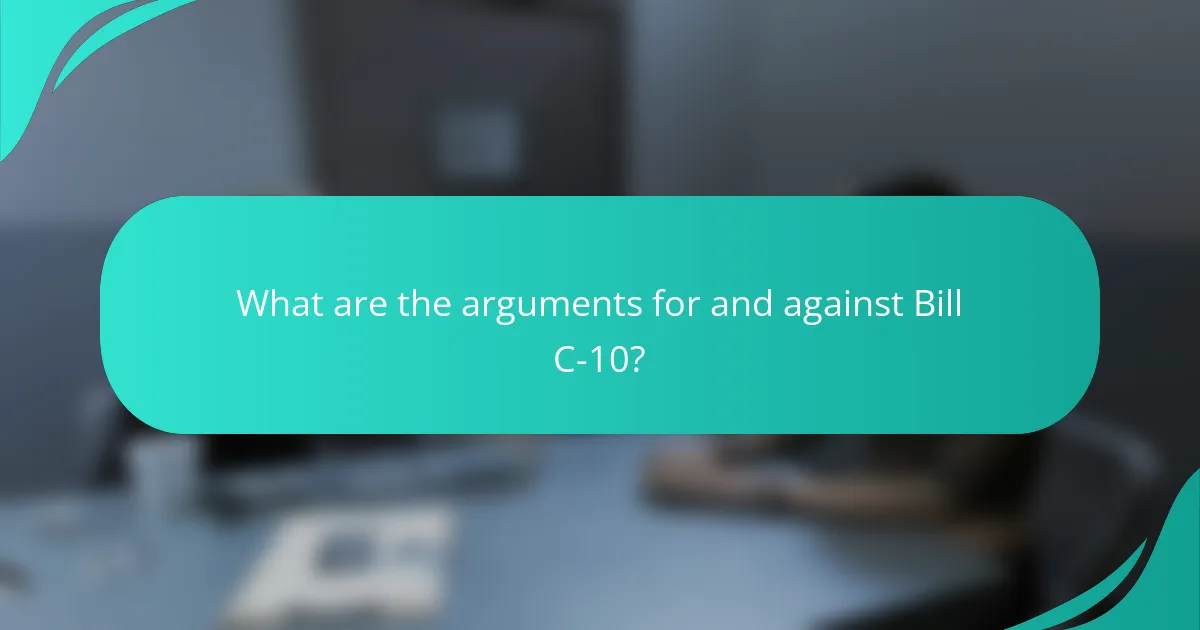
What is Bill C-10 and its relevance to Canadian Freedom of Expression?
Bill C-10 is a Canadian legislative proposal aimed at updating the Broadcasting Act. It seeks to regulate online streaming platforms to ensure they contribute to Canadian content creation. The bill’s relevance to Canadian freedom of expression lies in its potential impact on user-generated content. Critics argue it could limit the ability of individuals to freely share content online. Supporters contend it is necessary for promoting Canadian culture. The debate centers on balancing regulation with the right to express oneself freely in digital spaces.
How does Bill C-10 propose to change existing laws regarding expression?
Bill C-10 proposes to amend the Broadcasting Act to regulate online streaming platforms. This change aims to ensure that these platforms contribute to Canadian content creation. The bill seeks to extend the Canadian Radio-television and Telecommunications Commission’s (CRTC) authority over digital services. It intends to include user-generated content under regulatory oversight. This could potentially affect the freedom of expression by imposing requirements on content creators. Critics argue that this may lead to censorship or self-censorship among users. Proponents believe it will support Canadian culture and diversity in media. The bill reflects a shift in how expression is managed in the digital age.
What specific provisions does Bill C-10 include that impact freedom of expression?
Bill C-10 includes provisions that require social media platforms to regulate user-generated content. These regulations can limit the ability of individuals to express themselves freely online. The bill mandates that platforms must promote Canadian content, which may overshadow diverse voices. It also grants the Canadian Radio-television and Telecommunications Commission (CRTC) authority to oversee these platforms. This oversight could lead to censorship of content deemed inappropriate or non-compliant. Critics argue these measures threaten free speech by imposing restrictions on expression. The potential for penalties against platforms that fail to comply raises concerns about self-censorship. Overall, these provisions could significantly influence the landscape of freedom of expression in Canada.
How do these provisions compare to previous legislation?
The provisions of Bill C-10 introduce significant changes compared to previous legislation. Unlike earlier laws, Bill C-10 expands the definition of regulated online content. This includes user-generated content, which was not previously covered. Additionally, the bill imposes new obligations on digital platforms for content moderation. Previous legislation did not require such comprehensive oversight from online services. The new provisions aim to enhance Canadian content visibility and promote cultural diversity. This contrasts with prior laws that focused mainly on traditional media. Overall, Bill C-10 represents a shift towards a more inclusive regulatory framework for digital expression.
Why is the discussion around Bill C-10 important for Canadians?
The discussion around Bill C-10 is important for Canadians because it directly impacts freedom of expression. Bill C-10 aims to regulate online streaming services in Canada. This regulation raises concerns about potential censorship of content. Critics argue that it could limit the diversity of voices in media. Supporters believe it will promote Canadian culture and content. The debate highlights the balance between regulation and free speech. Understanding this balance is crucial for maintaining democratic values. The outcomes of this discussion will shape the future of Canadian media and expression rights.
What historical context surrounds freedom of expression in Canada?
Freedom of expression in Canada has deep historical roots. It is primarily influenced by the Canadian Charter of Rights and Freedoms, enacted in 1982. This Charter guarantees fundamental freedoms, including freedom of thought, belief, opinion, and expression. Prior to the Charter, freedom of expression was protected under common law and various provincial statutes. Landmark cases, such as R v. Keegstra in 1990, shaped the legal landscape by addressing hate speech and its limitations. Additionally, the evolution of media and technology has continuously impacted how freedom of expression is understood. The historical context reflects a balance between protecting individual rights and maintaining social order.
How have previous laws influenced the current landscape of expression in Canada?
Previous laws have significantly shaped the current landscape of expression in Canada. The Canadian Charter of Rights and Freedoms, enacted in 1982, established freedom of expression as a fundamental right. This framework has influenced subsequent legislation, including laws regulating hate speech and obscenity. For instance, the Criminal Code of Canada prohibits hate propaganda, balancing free expression with public safety. Additionally, the Broadcasting Act has evolved to address diverse content, impacting how media expression is regulated. Recent discussions around Bill C-10 further reflect ongoing tensions between regulation and freedom. These historical laws create a complex environment where expression is both protected and limited, illustrating the ongoing negotiation between rights and societal values.

What are the potential impacts of Bill C-10 on various stakeholders?
Bill C-10 may significantly impact various stakeholders in Canada. Content creators could face increased regulation, affecting their creative freedom. Streaming services may need to alter content offerings to comply with Canadian content requirements. This could lead to reduced diversity in available programming. Broadcasters might experience a shift in audience engagement as regulations evolve. Consumers could see changes in content accessibility and variety. Advocacy groups may raise concerns about potential censorship. Overall, the implications of Bill C-10 will influence the media landscape and freedom of expression in Canada.
How might content creators be affected by Bill C-10?
Content creators may face increased regulation and oversight under Bill C-10. The bill aims to amend the Broadcasting Act, which could require online platforms to adhere to Canadian content rules. This change may limit the visibility of independent creators who do not produce content that meets regulatory standards. Additionally, the bill could impose financial obligations on platforms, impacting how creators monetize their work. Critics argue that such measures could stifle creativity and reduce the diversity of content available to audiences. The potential for increased compliance costs may also deter new creators from entering the market. Overall, Bill C-10 presents challenges that could reshape the landscape for Canadian content creators.
What challenges could content creators face under the new regulations?
Content creators could face significant challenges under the new regulations of Bill C-10. These challenges include increased censorship of their content. The regulations may impose stricter guidelines on what can be shared online. Content creators might struggle to navigate these complex rules. There is a risk of losing creative freedom and expression. Additionally, creators may face penalties for non-compliance, which could deter content production. The ambiguity in the regulations can lead to confusion about acceptable content. This uncertainty may hinder the growth of diverse voices in the Canadian digital landscape.
How might content creators respond to the changes introduced by Bill C-10?
Content creators may respond to the changes introduced by Bill C-10 by adapting their content strategies. They might increase focus on compliant content to meet regulatory requirements. Some creators may explore new platforms that align with the updated laws. Others could engage in advocacy for clearer regulations. Additionally, content creators may collaborate with legal experts to ensure compliance. They might also diversify their revenue streams to mitigate potential impacts. Overall, responses will vary based on individual creator circumstances and content types.
What implications does Bill C-10 have for social media platforms?
Bill C-10 imposes regulatory obligations on social media platforms in Canada. It aims to ensure that these platforms contribute to the creation and promotion of Canadian content. The bill requires platforms to implement measures that enhance the visibility of Canadian creators. It also mandates reporting on their compliance with these requirements. Failure to comply may result in penalties. Critics argue that it could limit freedom of expression by imposing content regulations. Supporters believe it will strengthen Canadian cultural identity online. The implications are significant for how social media operates within Canadian jurisdiction.
How could social media companies adapt to comply with Bill C-10?
Social media companies could adapt to comply with Bill C-10 by implementing content moderation policies aligned with Canadian broadcasting standards. They must assess and categorize user-generated content to ensure compliance with the regulations set forth in the bill. This includes promoting Canadian content and ensuring that algorithms prioritize local creators. Additionally, they should enhance transparency by providing users with information on how content is moderated and prioritized. Regular reporting on compliance efforts may also be necessary to demonstrate adherence to the law. These adaptations are crucial for maintaining their operations within Canada while respecting local regulations.
What role do social media platforms play in shaping public discourse?
Social media platforms significantly influence public discourse by facilitating communication and information sharing. They allow users to express opinions and engage in discussions on various topics. This interaction shapes societal views and public opinion. Research indicates that platforms like Twitter and Facebook amplify certain narratives through algorithms that prioritize popular content. According to a study by the Pew Research Center, 64% of Americans believe social media has a positive impact on their ability to connect with others. Furthermore, social media can create echo chambers, reinforcing existing beliefs among users. This dynamic can lead to polarized views, impacting democratic processes and public policy discussions.

What are the arguments for and against Bill C-10?
Bill C-10 has arguments both for and against it. Proponents argue it aims to modernize the Broadcasting Act. They believe it will enhance the visibility of Canadian content online. Supporters say it helps protect Canadian culture in a digital landscape. They assert that it ensures fair competition for Canadian creators.
Opponents argue it threatens freedom of expression. Critics claim it could lead to government overreach in regulating online content. They worry about the potential for censorship of user-generated content. Detractors believe it may stifle creativity and innovation in digital platforms.
What are the main arguments supporting Bill C-10?
The main arguments supporting Bill C-10 include enhancing the visibility of Canadian content. Supporters assert that it aims to promote Canadian culture in the digital landscape. They argue it levels the playing field for Canadian creators against global platforms. Bill C-10 is seen as a means to ensure that streaming services contribute to Canadian content funding. Additionally, proponents believe it will support jobs in the creative industry. They highlight that the bill seeks to modernize broadcasting regulations. This modernization is argued to be necessary for adapting to digital consumption trends. Ultimately, supporters claim that Bill C-10 will enrich the diversity of voices in Canadian media.
How do proponents believe Bill C-10 will enhance Canadian culture?
Proponents believe Bill C-10 will enhance Canadian culture by promoting local content in digital media. They argue that the bill will ensure Canadian creators receive greater visibility. This visibility is expected to lead to a more diverse representation of Canadian stories. Enhanced funding for Canadian productions is also anticipated. This funding could support various artistic forms, including music and film. Proponents cite examples from other countries where similar regulations have boosted local industries. They point to increased audience engagement with homegrown content as a positive outcome. Overall, they believe Bill C-10 will strengthen national identity through cultural expression.
What safeguards are proposed to protect freedom of expression?
Proposed safeguards to protect freedom of expression include clear definitions of harmful content. Bill C-10 aims to limit government overreach in regulating online speech. It emphasizes transparency in content moderation practices. Additionally, there are provisions for public consultation on regulatory changes. The bill also seeks to ensure that creators maintain control over their content. Furthermore, it includes mechanisms for appeal against content removal decisions. These safeguards are designed to balance regulation with the protection of individual rights. They reflect ongoing discussions about maintaining free expression in digital spaces.
What criticisms have been raised against Bill C-10?
Criticisms against Bill C-10 include concerns about potential censorship. Critics argue that the bill may infringe on freedom of expression. They highlight that it could empower the government to regulate online content. This regulation might lead to the suppression of diverse viewpoints. Additionally, some believe it targets user-generated content unfairly. Critics also point out that vague language in the bill raises ambiguity. This ambiguity could result in unintended consequences for creators. Overall, these criticisms emphasize the need for careful consideration of free speech implications.
What concerns do critics express about potential censorship?
Critics express concerns that potential censorship under Bill C-10 could undermine freedom of expression in Canada. They argue that the bill may lead to government overreach in regulating online content. Critics fear this regulation could stifle diverse voices and limit access to information. They highlight that vague definitions in the bill could result in arbitrary enforcement. Additionally, there are worries about the chilling effect on creators and artists. Critics emphasize that self-censorship may occur if individuals fear repercussions for their content. Historical instances of censorship in Canada serve as a reminder of the risks involved. Overall, these concerns point to a potential erosion of democratic values surrounding free speech.
How do critics argue that Bill C-10 could impact public discourse?
Critics argue that Bill C-10 could restrict public discourse by imposing regulations on online content. They believe it may limit the diversity of voices and opinions available. The bill could give the government increased control over what is shared online. Critics fear this could lead to censorship of unpopular or dissenting views. They highlight that the bill’s vague language may create uncertainty for content creators. This uncertainty could discourage individuals from expressing their thoughts freely. Critics also point out that it could disproportionately affect marginalized groups. They argue that these groups may face additional barriers to sharing their perspectives.
What can Canadians do to engage with the implications of Bill C-10?
Canadians can engage with the implications of Bill C-10 by participating in public consultations. They can provide feedback during government hearings or discussions about the bill. Citizens can also join advocacy groups that focus on freedom of expression issues. Engaging with local representatives about concerns related to the bill is another effective approach. Additionally, Canadians can educate themselves and others about the bill’s provisions and potential impacts. Sharing information on social media can raise awareness among broader audiences. Participating in community forums or workshops can facilitate informed discussions on the topic. Finally, Canadians can support media organizations that promote transparency and accountability regarding the bill.
Bill C-10 is a Canadian legislative proposal aimed at updating the Broadcasting Act to regulate online streaming platforms and ensure their contribution to Canadian content creation. The article examines the implications of Bill C-10 on freedom of expression, highlighting concerns about potential censorship and the impact on user-generated content. It discusses the provisions of the bill, its historical context, and the perspectives of various stakeholders, including content creators and social media platforms. The analysis also addresses arguments for and against the bill, emphasizing the balance between promoting Canadian culture and protecting individual rights in the digital landscape.




